Health
Avocado Puree (Homemade Baby Food)

This post may contain affiliate links. As an Amazon Associate, I earn from qualifying purchases. Please read my disclosure.
My creamy avocado puree recipe is a perfect first food for your baby! Packed with essential nutrients for growth and development, it requires no special equipment and is ready in less than 5 minutes. This avocado baby food will quickly become one of your favorite baby food recipes, and the best part is that babies love it!
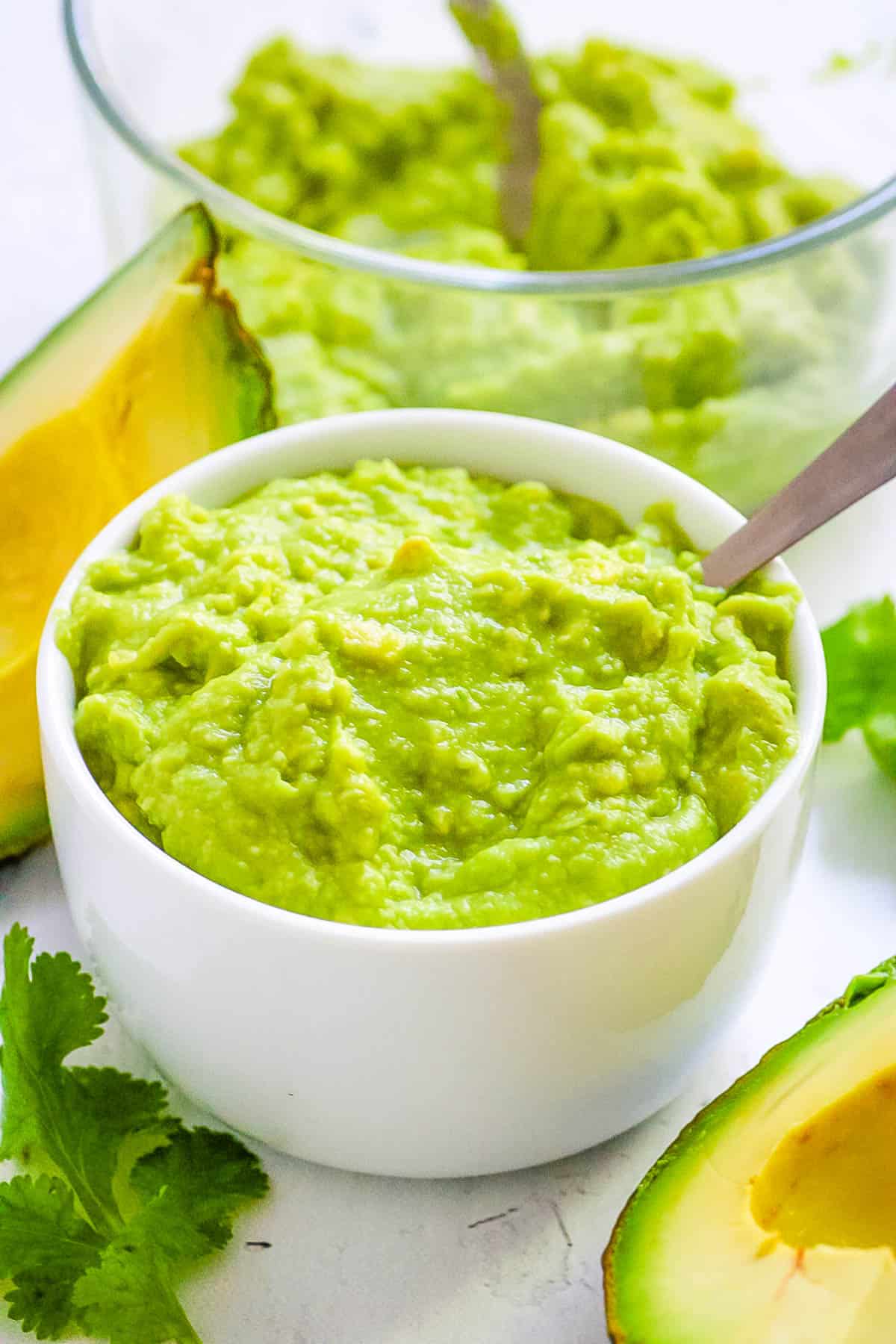
Avocado is one of the best first foods to introduce to your baby. It is buttery, creamy, and super soft and has amazing health benefits to aid in your baby’s growth and brain development.
It was actually my daughter’s first solid food and it quickly became a favorite of hers! When I was first introducing avocado to baby, I mixed avocado and breast milk together to form a creamy liquid. Making avocado puree for babies is totally effortless.
With just a quick mash up I was able to create a healthy food that I felt good about giving both of my kids when they were starting on solids!
My baby avocado puree requires no special equipment and takes just minutes to make. All you need is a ripe avocado, a little liquid, and a fork or blender. I would often double or triple the recipe and store it in the fridge or freezer, which made it great for meal prep. It’s also incredibly convenient for busy parents.
Avocados are also a nutritional powerhouse! They are rich in omega-3 fatty acids, and just half an avocado provides a good portion of your daily values of Vitamins C, E, K, Folate, Magnesium, Potassium, most B Vitamins, and about 19% of your total fat needs (source).
Plus, my homemade avocado first baby food is less sweet than many other types of baby puree and has a similar fat content to mother’s milk, making it easier for babies to digest. I have found, through my experience with my own kids and with working with other parents, that it’s important to keep a baby’s diet simple and limit the amount of sugar.
My recipe is 100% baby approved! Babies love the creamy, buttery texture of this puree and it’s easy for them to swallow. And as your baby grows, you can try different variations and mix-ins to keep things interesting like combining it with my blueberry baby food or my green bean puree.
Latest Recipe Video!
🥘 Ingredients
My avocado baby food recipe is the easiest recipe ever. At its most minimal form, you will only need 1 avocado! Scroll down to the recipe card at the bottom of the post for more details.
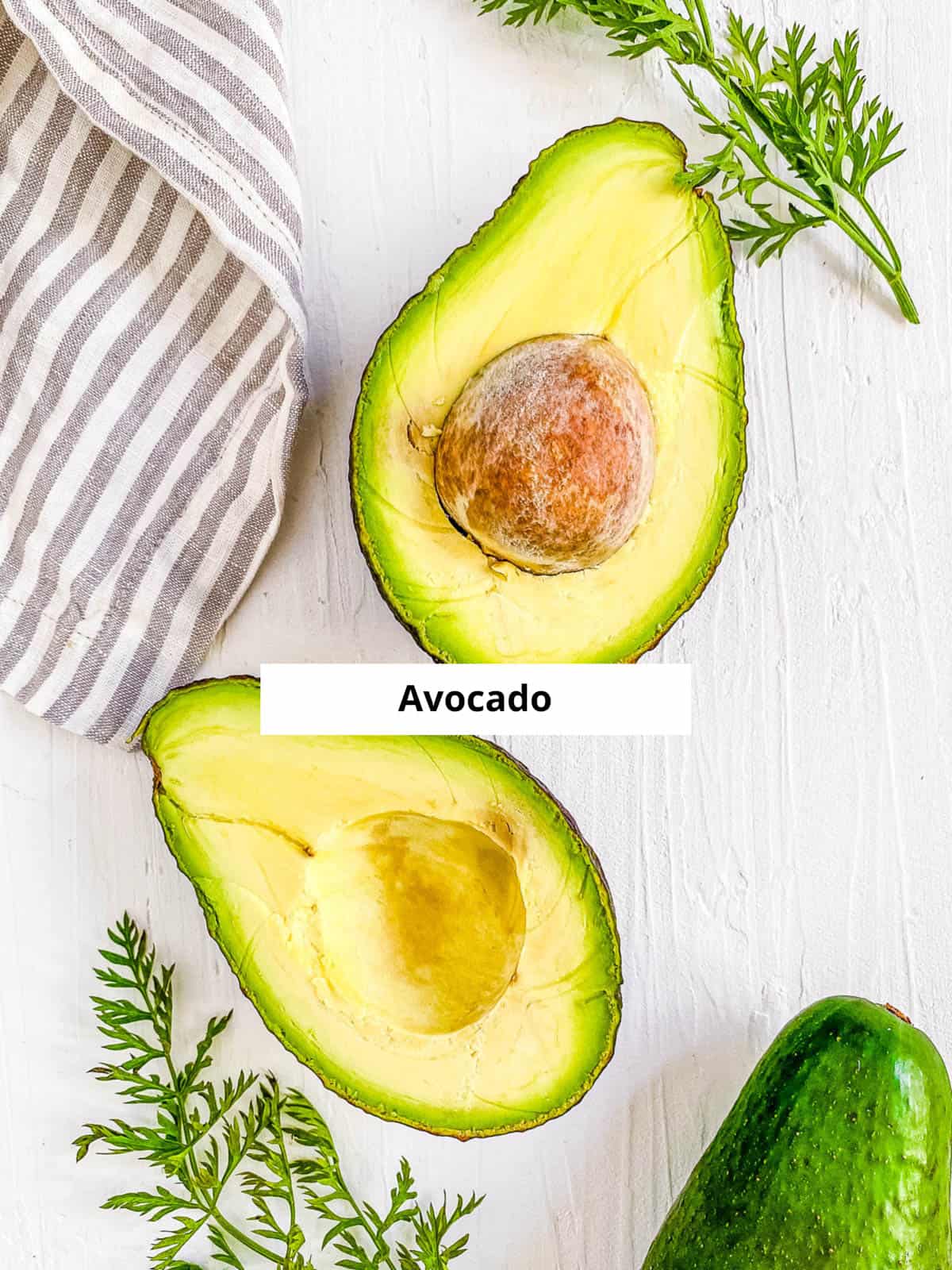
Avocado: Nutrient-rich avocado makes a wonderful first food for babies with healthy fats and vitamins (source). I always used organic avocado when making baby food.
Breast Milk, Formula, Or Water: You’ll need a small amount of liquid to create the perfect creamy texture. If using water, I’ve found that you just need a little or it can get runny. If you’re mixing avocado and breastmilk or formula I recommend doing it right before serving. You can’t store this baby food after it’s been mixed with breastmilk or formula.
🔪 How To Make Avocado Puree For Baby
The great news is that learning how to make avocado baby food is super easy! If you’re wondering do you cook avocado for baby food, the answer is no! It requires no cooking at all, and there are two simple ways to do it: blend or mash!
Watch my video below for a step-by-step guide on how to puree avocado for baby.
Prepare Avocado: To begin, I cut open my ripe avocado, remove the pit, scoop the flesh out, and discard the peels. When making my avocado puree recipe for baby all of the skin should be removed.
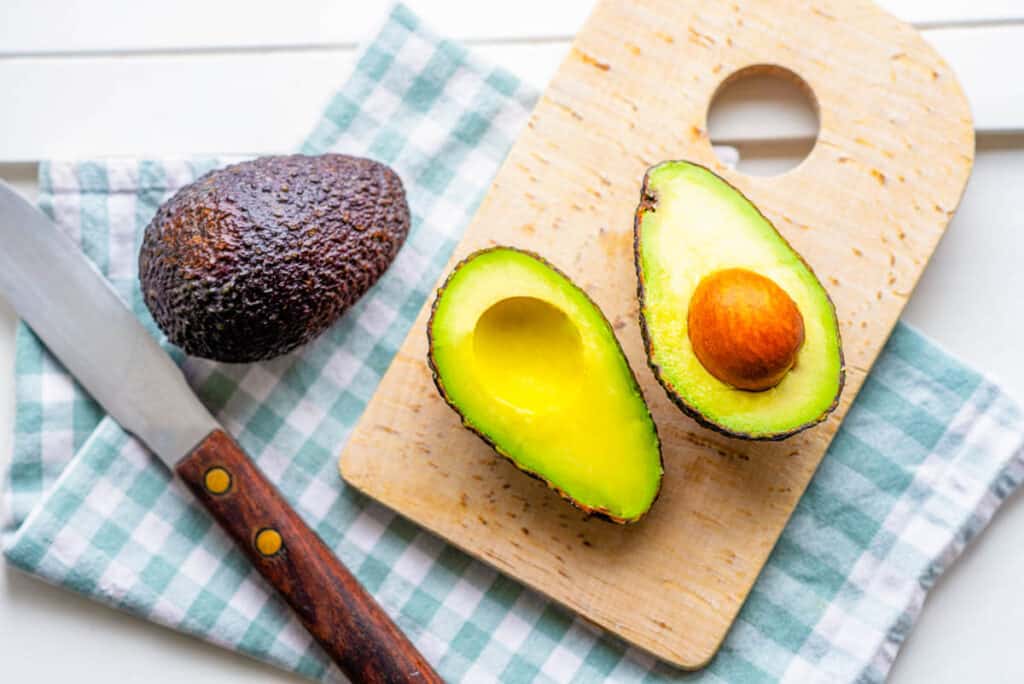
Blend: There are two methods for how to puree avocado. You can blend the whole avocado in a small food processor or use a fork to make mashed avocado for baby. If you’re using a blender, I recommend a high powered blender to make the puree in bulk – like a Vitamix!

Serve: If serving immediately mix pureed avocado with breast milk, formula, or water to reach desired consistency. If freezing for later use, divide into an ice cube tray, cover, and store in the freezer. When ready to serve, thaw out the prepared avocado, mix milk, and feed.
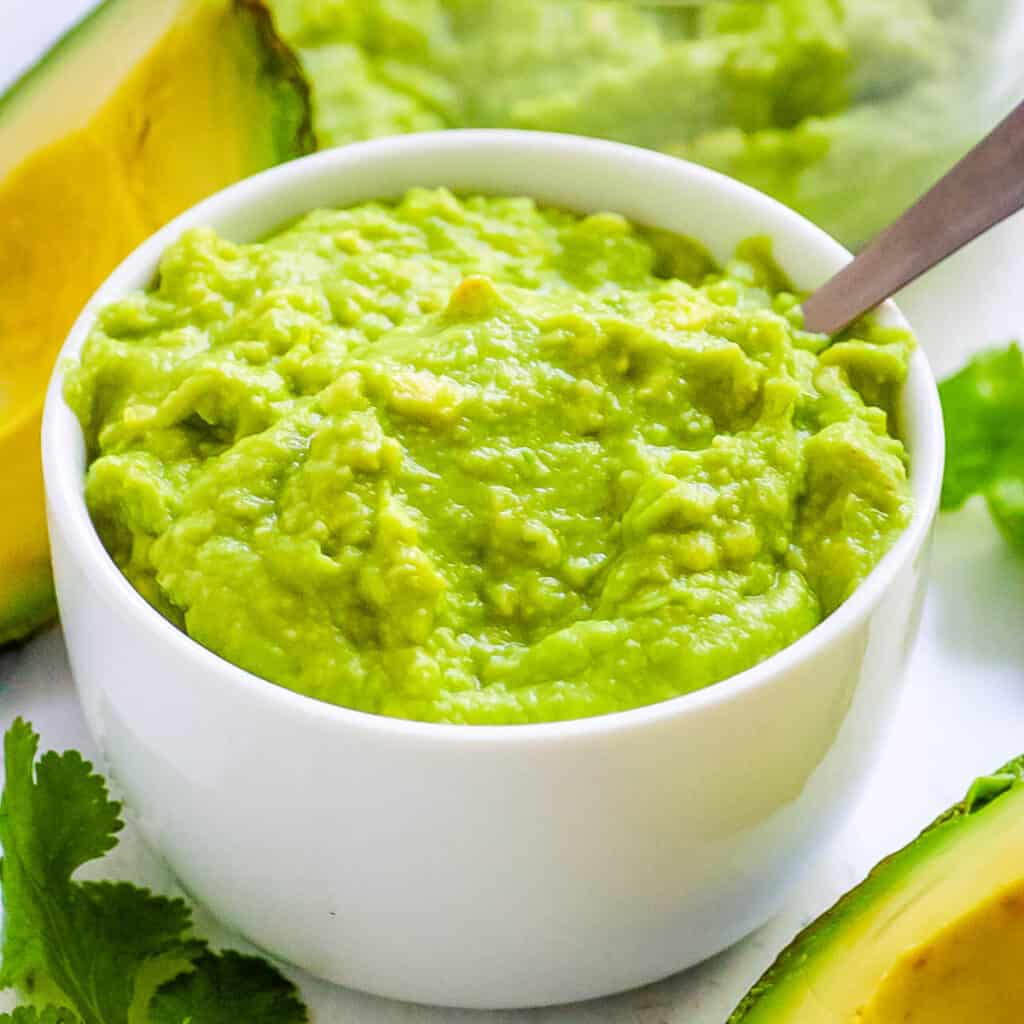
✔️ How To Choose The Best Avocado
Most grocery stores have avocados available at various stages of ripeness. If you plan to make my avocado baby puree in a few days from now, I suggest choosing hard avocados that have time to soften. If you want to make the puree right away, select an avocado that is dark brown on the outside and slightly indents when pushing against the skin.
Avoid an overly ripe and mushy avocado. Also, if you can afford it, I recommend using 100% organic ingredients for your baby’s food.
🥑 How To Cut An Avocado
I cut fresh avocados in half with a sharp knife, gently twisting to separate the two halves. I remove the pit either with my hands or by carefully hitting my knife into it and then twisting to remove the seed from the flesh. Then, I scoop the avocado flesh out with a spoon.
Once the flesh is removed, you don’t have to cut the avocado any further. My avocado recipe for baby has you mash or blend the whole fruit.
My #1 Secret Tip when making my easy avocado puree for your baby is to mix it with breast milk or formula right before serving. Mixing just before serving prevents bacterial growth, maintains the best texture, and ensures your baby gets the maximum nutritional benefits from both the avocado and the milk.
Other Tips To Keep In Mind:
- Prevent Browning: Avocado can brown quickly once exposed to air. To minimize browning, you can add a small amount of lemon or lime juice to the puree. Another option is to store the puree in an airtight container with plastic wrap pressed directly onto the surface to limit air exposure.
- Use A Fine Mesh Sieve: For an ultra-smooth puree, pass the mashed or blended avocado through a fine mesh sieve. This ensures there are no lumps, making it easier for younger babies to swallow.
- Speed Up Avocado Ripening: To ripen avocados quickly, I’ll place them in a brown paper bag with an apple or banana. The ethylene gas produced by these fruits speeds up the ripening process. Check the avocados daily to ensure they don’t become overripe.
🍽 How To Serve To Baby
If you prefer a clean space with minimal clean up, you will want to spoon feed your baby. However, if you are opting for baby led weaning, you can place the puree in front of your little one and let them explore on their own terms. I did both types of feeding techniques with my kids, and found a combination worked best.
Here are some of the different ways to serve my homemade avocado baby food based on age, as well as your child’s preference:
- Avocado puree for 4 month baby: Super simple avocado is a perfect first food for babies! I recommend feeding mashed avocado/puree to babies 4 months and up. Place the puree in a bowl and feed it to your baby with a spoon. Once they get a little older you can explore different textures and shapes.
- Avocado puree for 6 month old baby: If you are exploring baby led weaning, you can offer thick strips of avocado. Place the avocado on their high chair tray and let them experiment. To help with gripping, leave part of the skin on or roll the avocado slices in hemp seeds.
- Avocado puree for 9-10 month old baby: At this age your baby can enjoy more finger food. Try putting cubed avocado in baby’s bowl and let them naturally explore the taste and feel.
Other Ways To Use Pureed Avocado
Ultimately, there are so many suggestions on how to feed a baby avocado. Go with what works best for you and your little one!
📖 Avocado Baby Food Combinations
Avocados are a great first food for babies because of their mild flavor. They pair really well with a variety of other fruits, veggies, and grains to create delicious and nutritious baby food purees. There are so many baby friendly avocado recipes you can try out! Here are some of my favorite avocado puree ideas to get you started:
Avocado Puree Pairings
- Soft Fruits And Veggies: If you aren’t sure of what to mix with my avocado puree for baby, start with foods similar in texture like bananas, apples, or sweet potato puree.
- Other Fruits: Mangoes, peaches, blueberries, pineapple, and strawberries all taste great with pureed avocado.
- Green Veggies: Try other pairings like mixing with spinach, broccoli, zucchini puree or pea puree.
- Root Veggies: Veggies like potatoes, butternut squash, and carrots all mix well with avocado food for baby.
- On Its Own: When your baby is little, it’s great on its own! Most little ones love this avocado stage 1 baby food. Honestly, sometimes my kids, who are older now, will still just eat avocado as a snack!
- With Grains: You can put the smooth puree on small sticks of toast or teething crackers. You could also mix it into baby oatmeal or baby cereal.
- With Dairy Or Plant Based Protein: Try mixing it with yogurt or cottage cheese! You can also puree it with chickpeas, lentils, or white beans for an avocado “hummus.”
- Different Spices: Try a pinch of lemon juice, cumin, coriander, or even curry powder.
- Ideas For Toddlers: As your baby gets older try adding the puree to smoothies, avocado toast, guacamole, or on top of Mexican food! You can pair avocado with small pieces of chicken breast, or if you are vegan, substitute with tofu.
- Baby Friendly Guacamole: Try experimenting with different flavors by blending avocado with lime juice, olive oil, kosher salt, and 1 garlic clove. This is perfect to pair with Mexican recipes or Spanish recipes, and the whole family can enjoy it too!
🧊 Storage Directions
After you learn how to prepare avocado for baby, it’s just as important to know how to store it properly so it stays fresh. And if you’ve been wondering – can you freeze pureed avocado for baby? Yes! You totally can!
Fridge
I store extra puree in an airtight container in the fridge for the next day. I recommend finding small food storage containers that leave less room for air, and evenly portion it out. You can add a squeeze of fresh lemon juice or lime juice to the exposed part of the puree to prevent browning if desired.
Freezer
When freezing, I divide my avocado puree baby food evenly into an ice cube tray. Wrap it tightly with plastic wrap or use a freezer storage bag. You can also find baby food container trays that come with lids to cover like these Mumi & Bubi ice cube trays. I love them because they come with a cover, a recipe book, and the cubes are super easy to get out. One ice cube is equal to 1 tablespoon or 1 ounce of food.
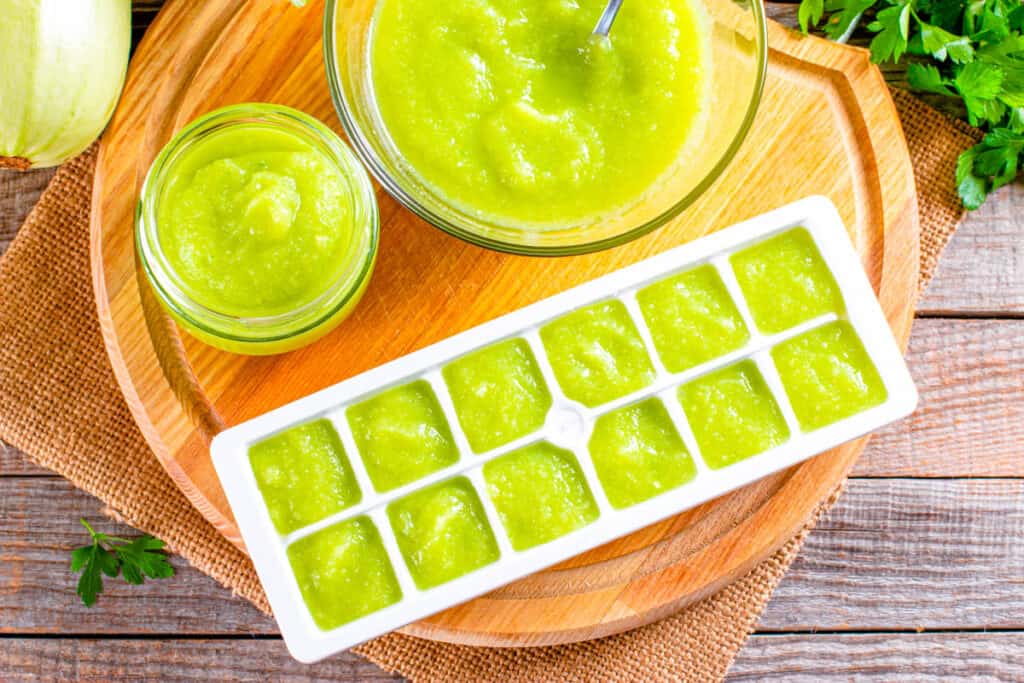
Once the cubes are frozen (takes about 4-6 hours), pop them out of the ice cube trays and transfer them to a ziptop freezer safe bag for easy storage.
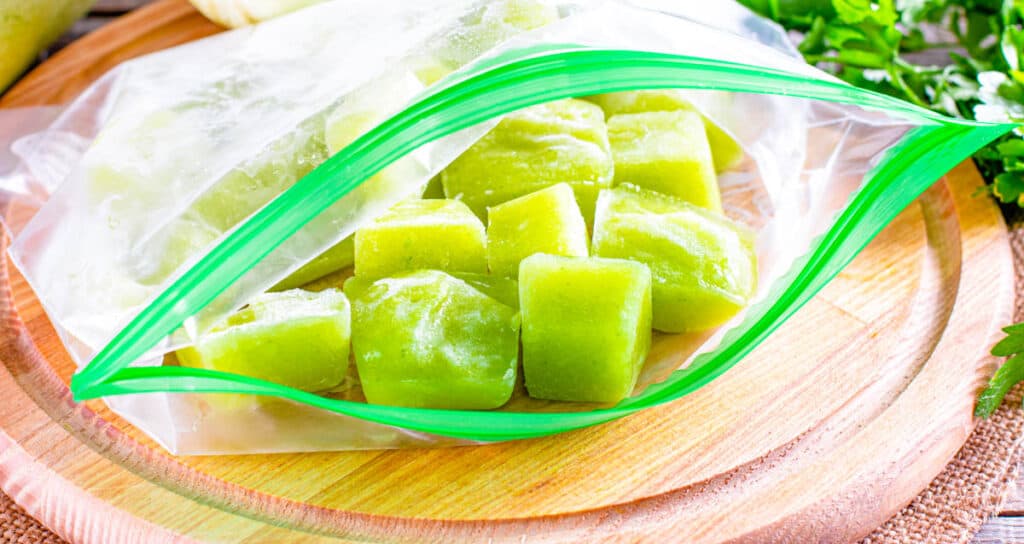
Reheating Or Thawing
When preparing avocado for baby, I would always thaw any frozen puree in the fridge the night before use. You can also thaw it by placing the puree cube in a small bowl over another bowl of hot water and letting it sit to defrost. Once defrosted, mix with breast milk, formula, or water to reach the desired consistency.
❓Recipe FAQs
You may be wondering – when can you introduce avocados to baby? This will depend on their own personal development and when they are ready to start solid foods, but typically it’s around 4-6 months of age. I gave both of my kids avocado as their first food when they were around 5 months old.
Pay attention to gross motor skills for an indication that your baby is ready! This could include having strong neck and head control, sitting, and lifting objects to the mouth.
No, avocado is not considered to be a common allergen for babies! However, if this is your first time giving avocado to baby I recommend starting off with a smaller portion of avocado and waiting for 2-3 days to observe for any signs of an allergic reaction such as a rash or upset stomach.
While technically you can steam avocado mash for baby, you don’t have to! There isn’t any need to steam or cook avocado for baby food since it is already so soft and creamy! This makes it super easy – you do not have to worry about extra steps like you might with other produce. Simply cut, scoop, and mash for an easy creamy puree.
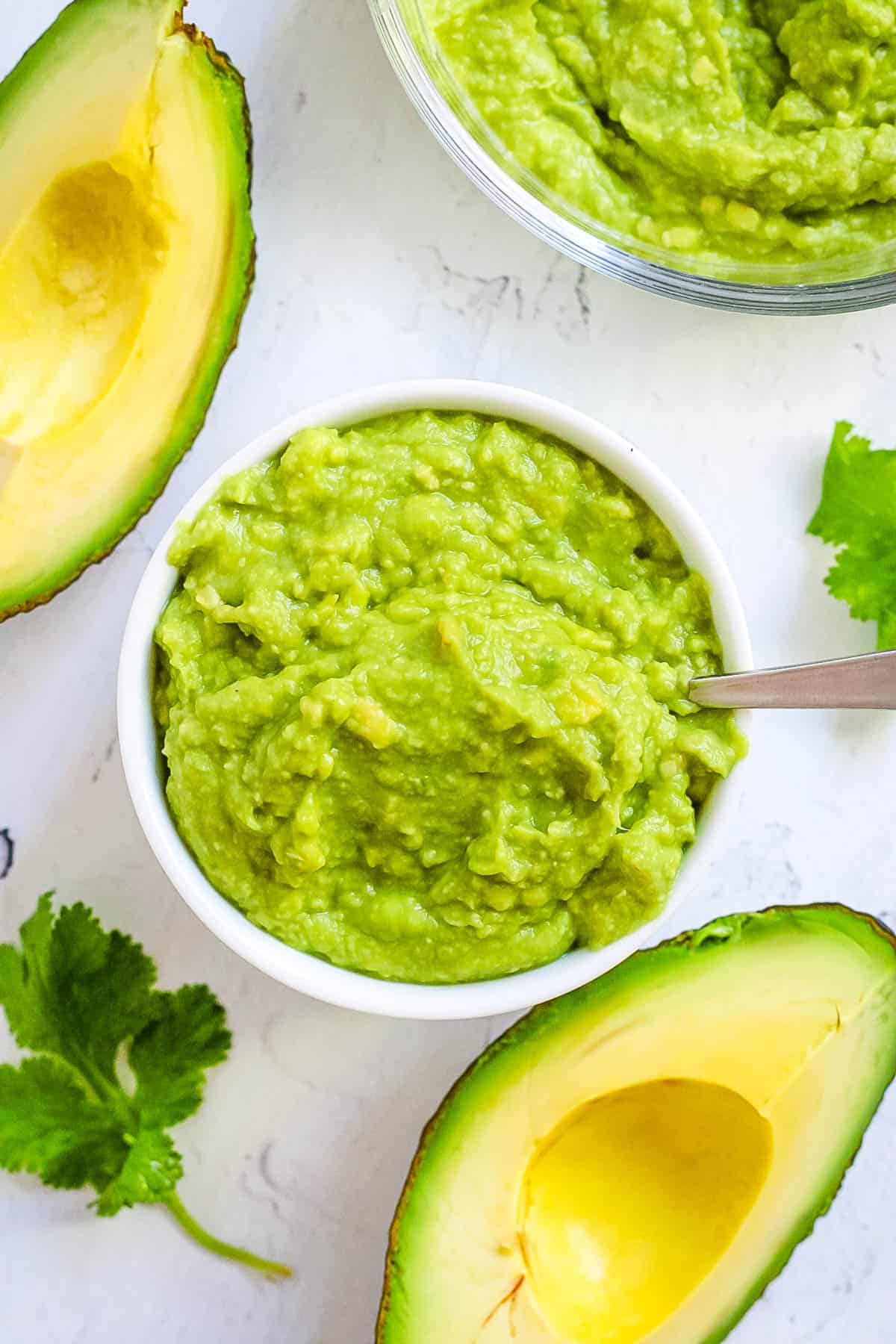
Want to Save This Recipe?
Enter your email & I’ll send it to your inbox. Plus, get great new recipes from me every week!
By submitting this form, you consent to receive emails from The Picky Eater.
Love this plant based baby food recipe? Please leave a 5-star rating 🌟 in the recipe below and/or a review in the comments section further down the page!
You can also FOLLOW ME on FACEBOOK, INSTAGRAM, and PINTEREST to see more delicious, healthy, family-friendly food, and if you have any questions, I’m here to help!
📋 Recipe Card
Avocado Puree: Baby’s First Food
My creamy avocado puree recipe is a perfect first food for your baby! Packed with essential nutrients for growth and development, it requires no special equipment and is ready in less than 5 minutes. This avocado baby food will quickly become one of your favorite baby food recipes, and the best part is that babies love it!
Servings: 4 servings
Calories: 80kcal
If Serving Fresh / Immediately
- Use ripe avocados that are soft and easy to mash.
- Store the puree in an airtight container in the refrigerator for up to 3 days or in the freezer for up to 3 months.
- If you are making this puree to store in the fridge or freezer, do not add breastmilk or formula before storing it. Only add breastmilk or formula right before serving.
- Each ice cube = 1oz of food. Also, as your baby gets used to solids, you don’t have to thin out the avocado at all.
Calories: 80kcal | Carbohydrates: 4g | Protein: 1g | Fat: 7g | Saturated Fat: 1g | Polyunsaturated Fat: 1g | Monounsaturated Fat: 5g | Sodium: 4mg | Potassium: 244mg | Fiber: 3g | Sugar: 0.3g
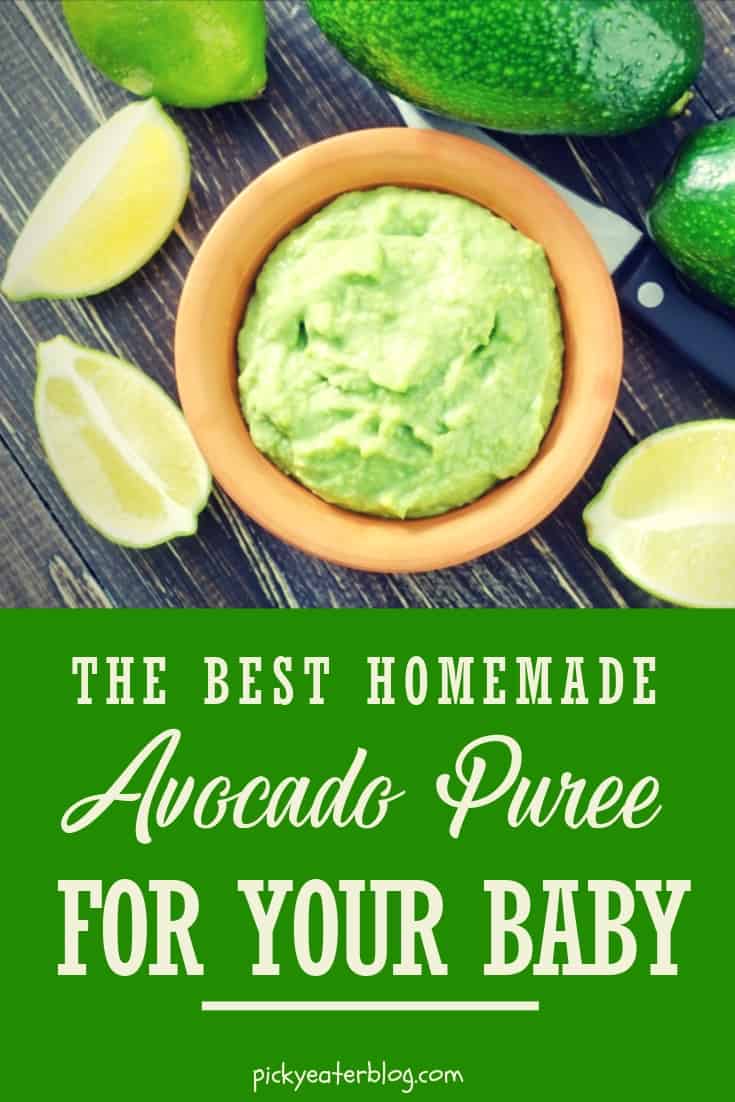
Health
Nursing Homes Are Left in the Dark as More Utilities Cut Power to Prevent Wildfires



By Kate Ruder
When powerful wind gusts created threatening wildfire conditions one day near Boulder, Colorado, the state’s largest utility cut power to 52,000 homes and businesses — including Frasier, an assisted living and skilled nursing facility.
It was the first time Xcel Energy preemptively switched off electricity in Colorado as a wildfire prevention tool, according to a company official. The practice, also known as public safety power shut-offs, has taken root in California and is spreading elsewhere as a way to keep downed and damaged power lines from sparking blazes and fueling the West’s more frequent and intense wildfires.
In Boulder, Frasier staff and residents heard about the planned outage from news reports. A Frasier official called the utility to confirm and was initially told the home’s power would not be affected. The utility then called back to say the home’s power would be cut, after all, said Tomas Mendez, Frasier’s vice president of operations. The home had just 75 minutes before Xcel Energy shut off the lights on April 6.
Staff rushed to prepare the 20-acre campus home to nearly 500 residents. Generators kept running the oxygen machines, most refrigerators and freezers, hallway lights, and Wi-Fi for phones and computers. But the heating system and some lights stayed off as the overnight temperature dipped into the 30s.
Power was restored to Frasier after 28 hours. During the shut-off, staff tended to nursing home and assisted living residents, many with dementia, Mendez said.
“These are the folks that depend on us for everything: meals, care, and medications,” he said.
Not knowing when power would be restored, even 24 hours into the crisis, was stressful and expensive, including the next-day cost of refilling fuel for two generators, Mendez said.
“We’re lucky we didn’t have any injuries or anything major, but it is likely these could happen when there are power outages — expected or unexpected. And that puts everyone at risk,” Mendez said.
As preemptive power cuts become more widespread, nursing homes are being forced to evaluate their preparedness. But it shouldn’t be up to the facilities alone, according to industry officials and academics: Better communication between utilities and nursing homes, and including the facilities in regional disaster preparedness plans, is critical to keep residents safe.
“We need to prioritize these folks so that when the power does go out, they get to the front of the line to restore their power accordingly,” said David Dosa, chief of geriatrics and professor of medicine at UMass Chan Medical School in Worcester, Massachusetts, of nursing home residents.
Restoring power to hospitals and nursing homes was a priority throughout the windstorm, wrote Xcel Energy spokesperson Tyler Bryant in an email. But, he acknowledged, public safety power shut-offs can improve, and the utility will work with community partners and the Colorado Public Utilities Commission to help health facilities prepare for extended power outages in the future.
When the forecast called for wind gusts of up to 100 mph on April 6, Xcel Energy implemented a public safety power shut-off. Nearly 275,000 customers were without power from the windstorm.
Officials had adapted after the Marshall Fire killed two people and destroyed or damaged more than 1,000 homes in Boulder and the neighboring communities of Louisville and Superior two and a half years ago. Two fires converged to form that blaze, and electricity from an Xcel Energy power line that detached from its pole in hurricane-force winds “was the most probable cause” of one of them.
“A preemptive shutdown is scary because you don’t really have an end in mind. They don’t tell you the duration,” said Jenny Albertson, director of quality and regulatory affairs for the Colorado Health Care Association and Center for Assisted Living.
More than half of nursing homes in the West are within 3.1 miles of an area with elevated wildfire risk, according to a study published last year. Yet, nursing homes with the greatest risk of fire danger in the Mountain West and Pacific Northwest had poorer compliance with federal emergency preparedness standards than their lower-risk counterparts.
Under federal guidelines, nursing homes must have disaster response plans that include emergency power or building evacuation. Those plans don’t necessarily include contingencies for public safety power shut-offs, which have increased in the past five years but are still relatively new. And nursing homes in the West are rushing to catch up.
In California, a more stringent law to bring emergency power in nursing homes up to code is expected by the California Association of Health Facilities to cost over $1 billion. But the state has not allocated any funding for these facilities to comply, said Corey Egel, the association’s director of public affairs. The association is asking state officials to delay implementation of the law for five years, to Jan. 1, 2029.
Most nursing homes operate on a razor’s edge in terms of federal reimbursement, Dosa said, and it’s incredibly expensive to retrofit an old building to keep up with new regulations.
Frasier’s three buildings for its 300 residents in independent living apartments each have their own generators, in addition to two generators for assisted living and skilled nursing, but none is hooked up to emergency air conditioning or heat because those systems require too much energy.
Keeping residents warm during a minus-10-degree night or cool during two 90-degree days in Boulder “are the kinds of things we need to think about as we consider a future with preemptive power outages,” Mendez said.
Federal audits of emergency preparedness at nursing homes in California and Colorado found facilities lacking. In Colorado, eight of 20 nursing homes had deficiencies related to emergency supplies and power, according to the report. These included three nursing homes without plans for alternate energy sources like generators and four nursing homes without documentation showing generators had been properly tested, maintained, and inspected.
For Debra Saliba, director of UCLA’s Anna and Harry Borun Center for Gerontological Research, making sure nursing homes are part of emergency response plans could help them respond effectively to any kind of power outage. Her study of nursing homes after a magnitude 6.7 earthquake that shook the Los Angeles area in 1994 motivated LA County to integrate nursing homes into community disaster plans and drills.
Too often, nursing homes are forgotten during emergencies because they are not seen by government agencies or utilities as health care facilities, like hospitals or dialysis centers, Saliba added.
Albertson said she is working with hospitals and community emergency response coalitions in Colorado on disaster preparedness plans that include nursing homes. But understanding Xcel Energy’s prioritization plan for power restoration would also help her prepare, she said.
Bryant said Xcel Energy’s prioritization plan for health facilities specifies not whether their electricity will be turned off during a public safety power shut-off — but how quickly it will be restored.
Julie Soltis, Frasier’s director of communications, said the home had plenty of blankets, flashlights, and batteries during the outage. But Frasier plans to invest in headlamps for caregivers, and during a town hall meeting, independent living residents were encouraged to purchase their own backup power for mobile phones and other electronics, she said.
Soltis hopes her facility is spared during the next public safety power shut-off or at least given more time to respond.
“With weather and climate change, this is definitely not the last time this will happen,” she said.
This article was produced by KFF Health News, a national newsroom that produces in-depth journalism about health issues and is one of the core operating programs at KFF — the independent source for health policy research, polling, and journalism.
KFF Health News is a national newsroom that produces in-depth journalism about health issues and is one of the core operating programs at KFF—an independent source of health policy research, polling, and journalism. Learn more about KFF.
USE OUR CONTENT
This story can be republished for free (details).
KFF Health News is a national newsroom that produces in-depth journalism about health issues and is one of the core operating programs at KFF—an independent source of health policy research, polling, and journalism. Learn more about KFF.
Subscribe to KFF Health News’ free Morning Briefing.
—
Previously Published on kffhealthnews.org
***
You Might Also Like These From The Good Men Project
Join The Good Men Project as a Premium Member today.
All Premium Members get to view The Good Men Project with NO ADS. A $50 annual membership gives you an all access pass. You can be a part of every call, group, class and community. A $25 annual membership gives you access to one class, one Social Interest group and our online communities. A $12 annual membership gives you access to our Friday calls with the publisher, our online community.
Register New Account
Need more info? A complete list of benefits is here.
—
Photo credit: iStock
Health
Being Seen and Heard: How to Make Sure Your Primary Care Provider Relationship Is Working for You



By MetroHealth, The Buckeye Flame
Primary care is critically important to your health. Routine visits, screenings and tests can identify underlying health concerns, catching diseases early when they are often easier to treat.
At the center of primary care is developing a relationship with a primary care provider: someone who sees and hears you, a safe and trusted ally in your journey to better health.
Unfortunately, according to a study by KFF (formerly the Kaiser Family Foundation), members of the LGBTQ+ community are less likely to have a regular doctor or healthcare provider than non-LGBTQ+ people. More alarming, the same study explains that LGBTQ+ people were “managing chronic conditions and living with disabilities that impact daily life at higher rates than non-LGBTQ+ people.”
According to Mark McLoney, MD, a primary care physician and medical director of the MetroHealth Pride Network, this disparity could be due to the LGBTQ+ community’s “tendency not to trust healthcare workers.”
Questions about a person’s sexual history are routine in all primary care visits—for people within and outside of the queer community. Because people in the queer community may not feel safe disclosing their sexual history prior to forming a trusted relationship with a provider, it leads to delayed care. Unfortunately, not every doctor is an ally.
“The queer community has been hurt by healthcare,” says McLoney. “People have been afraid to tell doctors about their sexual history, which allows them to be exposed to dangerous health issues.”
How to find the right provider for you
Members of the LGBTQ+ community have specific health concerns to discuss with their provider—and like anyone want to have those discussions in an open, affirming and respectful patient/provider relationship.
It’s a fact that makes starting the healthcare process difficult for some.


Mark McLoney, MD, a primary care physician and medical director of the MetroHealth Pride Network
McLoney suggests doing some research to find a provider who understands your needs. GLMA: Health Professionals Advancing LGBTQ+ Equality, is the world’s largest association of LGBTQ+ healthcare professionals, and maintains a provider directory on their website with providers who have self-selected as allies. McLoney also suggests checking with your local LGBTQ+ community center, as they often maintain a list of trusted, referred physicians. And, the MetroHealth Pride Network was Northeast Ohio’s first clinic to provide healthcare services specifically to the LGBTQ+ community—offering another starting point for locals.
It’s a relationship
McLoney strives to create a space that’s safe, where people can be themselves. He wears “flair”—buttons and pins on his lanyard and lab coat that help people identify him as an ally to people in the LGBTQ+ community.
On your first visit, he suggests emphasizing what you need most.
“Make a list of your biggest concerns,” McLoney advises. “While we might not get to every concern in your first visit, a written list will help you if you get nervous and help us prioritize care.”
While concerns specifically related to sexuality and gender may not be primary for patients in the initial visit, McLoney says that the way a provider asks about a patient’s sexual history can tell you a lot about the type of relationship you can have with your provider.
“Watch for a doctor’s nonverbal gestures and how they respond to your history,” McLoney says. “If they’re not hearing your underlying concerns, you don’t have to go back. And, if you ever feel unsafe or unheard, you can always feel free to end an appointment on your terms.”
McLoney suggests, at the end of the appointment, to take a moment afterwards to assess the visit. He suggests asking yourself three questions:
- Did my provider hear me?
- Did I feel comfortable asking questions?
- Did I feel comfortable being open and honest with my provider?
The MetroHealth Pride Network
The MetroHealth Pride Network offers primary care for adults and children and gender-affirming care for adults. While people in the LGBTQ+ community have similar routine healthcare needs as cisgender or heterosexual people, providers in the MetroHealth Pride Network have specialized training and experience related to sexuality and gender.
“We provide a place where patients can speak about themselves without having to do all of the explaining or education on what it means to be a member of the LGBTQ+ community,” says McLoney.
Pride Network providers can be found in four MetroHealth locations—Brecksville, Brooklyn, Cleveland Heights, and Rocky River as well as a clinic in the LGBT Community Center of Greater Cleveland. Learn more at www.metrohealth.org/pride. 🔥
—
The Buckeye Flame is an online platform dedicated to amplifying the voices of LGBTQ+ Ohioans to support community and civic empowerment through the creation of engaging content that chronicles their triumphs, struggles, and lived experiences.
***
You Might Also Like These From The Good Men Project
Join The Good Men Project as a Premium Member today.
All Premium Members get to view The Good Men Project with NO ADS.
A $50 annual membership gives you an all access pass. You can be a part of every call, group, class and community.
A $25 annual membership gives you access to one class, one Social Interest group and our online communities.
A $12 annual membership gives you access to our Friday calls with the publisher, our online community.
Register New Account
Need more info? A complete list of benefits is here.
—
Photo credit: The Buckeye Flame
Health
Back to School Solutions for the Principal

As the head administrator in the school building, the principal is responsible for the learning and wellness of all teachers, staff, and students. And like the people they oversee, back to school season for the school principal is exciting, full of potential, and deeply stressful.
Our experts at School Specialty constantly review our products to ensure they help your staff and students meet their goals. How do we know they’re experts? Because they were teachers!
We know we can’t solve every obstacle principals face, but that will never stop us from trying! Here are five areas where we want to help, and some curated items to supplement your efforts to provide a safe and successful learning environment.
Academic Achievement
It’s no surprise that the top of every educator’s wish for their students is academic achievement. Successful student outcomes require forward-thinking educators and principals who support them.
This often requires understanding that achievement may look different for each student. While some products may have a specific focus, the reality is that the most efficient tools will be just as useful for both the margins and the masses. Here are a few expert favorites to aid that effort.
Staff and Student Wellness
The physical and emotional wellness of educators and students is consistently shown to support student connectedness and success. For this reason, it’s often an area of emphasis for administrators.
From ensuring proper nutrition to promoting active learning to helping students manage stress and anxiety, we’re dedicated to providing the tools your schools need to support the wellness of all students and staff.
Maximize Budgets
School budgets are always a hot topic, and anyone involved in education likely has a strong opinion. But we consider it our responsibility to offer solutions that allow your school to achieve more with less. That’s why we rigorously test the durability of our brand products. We’re dedicated to ensuring you get name-brand quality supplies at affordable prices.
We’ve offered tips in the past on how to work within a budget to grow a classroom library, upgrade and update classroom storage, and take advantage of savings with classroom packs. Here are some more product ideas to help teachers get the most out of every dollar.
School Culture
Setting the tone of your school’s culture starts at the top. The principal can profoundly affect the confidence of students and staff and the prevention of bullying behavior.
These products are designed to encourage students to make positive decisions in how they treat themselves and each other. Build a culture that makes your school a welcoming place where kids want to come and learn.
Bullying prevention will help provide a safer school environment, but just as important as teaching students what not to do is encouraging them to lift each other up. Show all students they’re part of a school culture that values them with tools and manipulatives for a welcoming and inclusive classroom.
Student Engagement
Creating engaging learning environments can be done in several ways, depending on the needs of your students. Once you’ve identified what will best engage students and stimulate interest in their own learning, you then need to provide teachers with the tools they need to bring that vision to life.
The key is to provide students with choices so that they can find ways to make their education more meaningful. Perhaps they want to start a robotics program or strengthen a music program. It could even be as simple as providing sensory spaces that allow students to self-manage or taking a class outdoors to engage in active science learning.
If you’re looking for a more significant update for an engaging classroom experience, an interactive sensory corner would be a hit with students of all ages. These multisensory environments give students a calming experience, allowing them to relax and regain a sense of control.
The many ways schools evolve in teaching create a constant need for new tools to support new objectives. We may not have all the answers, but we hear your questions and won’t stop until we find solutions for every school and classroom.
Visit the School Specialty website for more information and ideas to reduce back to school stress so you can enjoy the unlimited potential of a new school year.
-

 African History5 years ago
African History5 years agoA Closer Look: Afro-Mexicans 🇲🇽
-

 African History5 months ago
African History5 months agoBlack History Facts I had to Learn on My Own pt.6 📜
-

 African History5 years ago
African History5 years agoA Closer Look: Afro-Mexicans 🇲🇽
-

 African History1 year ago
African History1 year agoMajor African Tribes taken away during the Atlantic Slave Trade🌍 #slavetrade #africanamericanhistory
-

 African History1 year ago
African History1 year agoCameroon 🇨🇲 World Cup History (1962-2022) #football #realmadrid #shorts
-

 African History5 months ago
African History5 months agoBlack History Inventors: Mary Kenner 🩸
-

 African History1 year ago
African History1 year agoPROOF AFRICAN AMERICANS AIN'T FROM AFRICA DOCUMENTED EVIDENCE
-

 African History1 year ago
African History1 year agoNo African pre-Columbus DNA? 🤯🤯 #history #mesoamerica #mexico #african



























